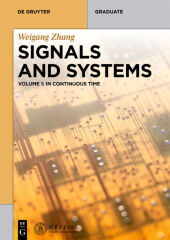 Neuerscheinungen 2017Stand: 2020-02-01 |
Schnellsuche
ISBN/Stichwort/Autor
|
Herderstraße 10
10625 Berlin
Tel.: 030 315 714 16
Fax 030 315 714 14
info@buchspektrum.de |

Weigang Zhang
In Continous Time
Herausgegeben von Zhang, Weigang
2017. XXII, 308 S. 140 b/w ill., 40 b/w tbl. 240 mm
Verlag/Jahr: DE GRUYTER; TSINGHUA UNIVERSITY PRESS 2017
ISBN: 3-11-041754-5 (3110417545)
Neue ISBN: 978-3-11-041754-8 (9783110417548)
Preis und Lieferzeit: Bitte klicken
The book begins by introducing signals and systems, and then discusses Time-Domain analysis and Frequency-Domain analysis for Continuous-Time systems. It also covers Z-transform, state-space analysis and system synthesis. The author provides abundant examples and exercises to facilitate learning, preparing students for subsequent courses on circuit analysis and communication theory.
Table of content:
Chapter 1 Signals
1.1 Definition of Signals
1.2 Classification of Signals
1.2.1 Periodic and Aperiodic Signals
1.2.2 Energy and Power Signals
1.2.3 Analog and Digital Signals
1.2.4 Certain and Random Signals
1.3 Basic Continuous-Time Signals
1.3.1 Direct Current Signals
1.3.2 Sinusoidal Signals
1.3.3 Exponential Signals
1.3.4 Complex Exponential Signals
1.3.5 Symbol Signal
1.3.6 Unit Ramp Signal
1.3.7 Unit Step Signal
1.3.8 Unit Impulse Signal
1.3.9 Unit Doublets Signal
1.4 Operation of Continuous-Time signals BR /1.4.1 Arithmetic Operation BR /1.4.2 Time Shifting Transform
1.4.3 Reversal Transform
1.4.4 Scaling Transform
1.4.5 Decomposition and Composition
1.4.6 Plotting of Signals
1.5 Learning Tip
1.6 Exercises
Chapter 2 Systems
2.1 Definition of Systems
2.2 State and Response of Systems
2.3 Classification of Systems
2.3.1 Linear and Nonlinear Systems
2.3.2 Time Variant and Invariant Systems
2.3.3 Dynamic and Non-Dynamic Systems BR /2.3.4 Continuous- and Discrete-Systems
2.3.5 Causal and Non-Casual Systems
2.3.6 Open-loop and Closed-loop Systems BR /2.3.7 Stable and Unstable Systems
2.3.8 Lumped-Parameter and Distributed-Parameter Systems
2.4 System Model and Operation Block Diagram BR /2.4.1 System Model
2.4.2 Operation Block Diagram
2.5 Learning Tip
2.6 Exercises
Chapter 3 Time-Domain Analysis for Continuous-Time System ;
3.1 Analytical Method of Differential Equation
3.1.1 Classical Analytical Method
3.1.2 Response Decomposition Method
3.2 Impulse Response and Step Response
3.2.1 Impulse Response
3.2.2 Step Response
3.3 Operator Analysis
3.2.1 Differential Operator and Transfer Operator
3.3.2 Determine Impulse Response by Transfer Operator
3.4 Convolution Method
3.4.1 Definition of Convolution
3.4.2 Properties of Convolution
3.4.3 Determine Zero-State Response by Convolution
3.5 Learning Tip
3.6 Exercises
Chapter 4 Real Frequency-Domain Analysis for Periodic Signals of Continuous-Time System
4.1 Orthogonal Functions
4.1.1 Orthogonal Function Set
4.1.2 Triangle Function Set
4.1.3 Imaginary Exponent Function Set
4.2 Fourier Series
4.2.1 Triangular Form of Fourier Series
4.2.2 Function Symmetry and Fourier Coefficient
4.2.3 Exponential Form of Fourier Series
4.2.4 Properties of Fourier Series
4.3 Frequency Spectrum of Signals
4.3.1 Definition of Frequency Spectrum
4.3.2 Characteristics of Frequency Spectrum
4.4 Fourier Series Analysis Method for Systems
4.4.1 System Function
4.4.2 Fourier Series Analysis Method
4.5 Learning Tip
4.6 Exercises
Chapter 5 Real Frequency-Domain Analysis for Aperiodic Signals of Continuous-Time System
5.1 Fourier Transform
5.1.1 Definition of Fourier Transform
5.1.2 Fourier Transform of Typical Aperiodic Signals
5.2 Properties of Fourier Transform
5.2.1 Linearity
5.2.2 Time Shifting
5.2.3 Frequency Shifting
5.2.4 Scaling Transform
5.2.5 Symmetry
5.2.6 Properties of Convolution
5.2.7 Differential in Time-Domain
5.2.8 Integration in Time-Domain
5.2.9 Modulation
5.3 Fourier Transform of Periodic Signals
5.4 Solution for Inverse Fourier Transform
5.5 Fourier Transform Analysis for Aperiodic Signals
5.5.1 System Model Analysis
5.5.2 System Function Analysis
5.5.3 Signal Decomposition Analysis
5.6 Fourier Transform Analysis for Periodic Signals
5.7 Undistorted Transmission Condition
5.8 Hilbert Transform
5.9 Disadvantages of Fourier Transform Analysis
5.10 Learning Tip
5.11 Exercises
Chapter 6 ; Complex Frequency-Domain Analysis for Continuous-Time System
6.1 Laplace Transform
6.1.1 Definition of Laplace Transform
6.1.2 Laplace Transform of Common Signals
6.1.3 Laplace Transform of Periodic Signals
6.2 Properties of Laplace Transform
6.2.1 Linearity
6.2.2 Time Shifting
6.2.3 Complex Frequency Shifting
6.2.4 Scaling Transform
6.2.5 Differential in Time-Domain
6.2.6 Integration in Time-Domain
6.2.7 Convolution Theorem
6.2.8 Initial-Value Theorem
6.2.9 Final-Value Theorem
6.


